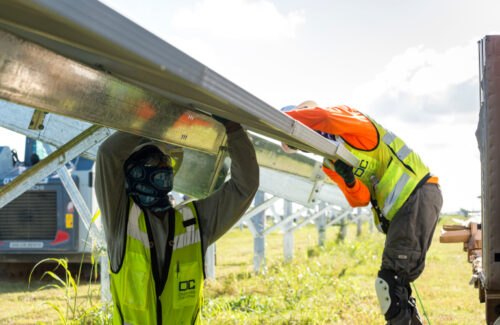In a 408-page report, the U.S. International Trade Commission (USITC) released its midterm findings on the effectiveness of tariffs on crystalline silicon PV (CSPV) cell and module imports. The independent report will be sent to the President and Congress, but the commission did acknowledge seven developments that have changed the industry since this latest round of Sec. 201 tariffs were initiated in February 2022 by President Biden.
The tariffs, first initiated in 2018 before being extended through 2026, aim to support domestic solar panel manufacturing by preventing cheap solar panels from other countries from being dumped into the market. Many U.S. players have exited the solar manufacturing market since 2018 — and many more have announced plans for new factories in the last two years — that the question of which companies need trade help is constantly in flux.
USITC listed the significant developments that have changed the domestic manufacturing market the most since 2022 as:
- Several announcements of plans to start domestic CSPV cell production in the near term;
- increased imports of CSPV cells and modules, particularly in the first half of 2023 compared to the first half of 2022;
- a shift in imports from non-bifacial CSPV cells and modules toward primarily bifacial CSPV cells and modules (bifacial modules are excluded from the safeguard measures) from 2020-22 and when comparing the first half of 2023 with the first half of 2022, with bifacial cells and modules increasingly used in traditionally non-bifacial applications;
- generally increased prices for CSPV cells and modules;
- decreased employment in the U.S. CSPV industry from 2020-22, but higher employment during the first half of 2023 compared with the first half of 2022;
- implementation of the Inflation Reduction Act (IRA), which has led to increased investments in domestic CSPV cell and module production; and
- an anti-circumvention inquiry by the Dept. of Commerce, which led to a Presidential moratorium on antidumping and countervailing duty (AD/CVD) tariffs on CSPV products imported from certain Southeast Asian countries.
At a midterm hearing in November 2023, most domestic solar panel manufacturers stated that the safeguard measures were still necessary to compete against imports. They also requested an increase in the amount of solar cells that could be imported tariff-free [currently the tariff-rate quota (TRQ) is 5 GW annually] so the increasing number of domestic panel assemblers won’t have to pay tariffs on imported solar cells while the United States slowly begins cell manufacturing at home.
Now that the midterm report has been filed, only the President can make legal changes to the in-progress tariff. In February 2020, the USITC stated in its midterm report to President Trump only that the industry had seen mixed results from the Sec. 201 tariffs. Nine months later, the president chose to increase the tariff rate and remove bifacial’s exemption.
Interestingly, the USITC stated in this midterm report that it had asked U.S. CSPV producers whether they had submitted adjustment plans to the commission or indicated that they would make adjustments in their operations that would permit them to compete more effectively with imports after the tariffs expire. All currently functioning domestic CSPV producers responded that they had not done so.
So the USITC included SolarWorld’s adjustment plan it had submitted back in 2017, which included thoughtful suggestions for more competition, lowered production costs and competitive government contracts. SolarWorld went out of business in 2018 before it could benefit from the first round of tariffs, but its outlook on the American solar panel manufacturing market and how to compete with foreign imports is still relevant to the market today. You can read SolarWorld’s excerpt below:



















